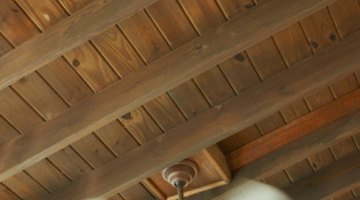Roof Rafter Design Specifications
The roof rafters of any structure must be carefully designed to accommodate the size of the structure and the expected roof loads. The design specifications must also identify how the outward thrust of the rafters will be resisted — a factor that is often overlooked, leading to sagging roofs and spreading walls.

Span
The size and spacing of the rafters depend primarily on the span, which is the horizontal distance over which the rafter must bear its load. In a standard gable roof, the span is measured from the wall to the middle of the structure. Span tables identify the required spacing and dimensions of rafter members based primarily on the span.
Snow Load
The expected snow load in a particular area also affects rafter design. The rafters must be strong enough to support any load that might be placed on the roof. Roof loads include construction workers, roofing equipment and wind, but in most areas, snow provides the heaviest load. For this reason, rafters are usually designed according to the expected snow load of the region. Detailed span tables identify rafter size and spacing according to span and snow load.
Roof Thrust
A standard gable roof is composed of two diagonal rafters that meet at the ridge. When the roof is loaded down, the ridge sinks and flattens the roof. This, in turn, pushes the walls outward. Rafters must be designed to accommodate some method of resisting this outward thrust. The two most common solutions are collar ties and ridge beams. Collar ties attach to opposite rafters and resist outward thrust through tension, whereas a ridge beam supports the ridge of the roof to prevent it from sinking. The rafter design might need to be adjusted according to the chosen method of resisting outward thrust.
Roof Pitch
The pitch, or slope, affects the rafter design in two ways. First, the various plumb cuts and level cuts on the rafter are made according to the pitch of the roof. Second, a roof with a small slope requires additional load-bearing considerations. Generally, span tables adjust the rafter specifications if the roof pitch is 3:12 or less.
References
Writer Bio
Joseph West has been writing about engineering, agriculture and religion since 2006. He is actively involved in the science and practice of sustainable agriculture and now writes primarily on these topics. He completed his copy-editing certificate in 2009 and holds a Bachelor of Science degree from the University of California-San Diego.
Photo Credits
- Jupiterimages/Photos.com/Getty Images
- Jupiterimages/Photos.com/Getty Images
More Articles



